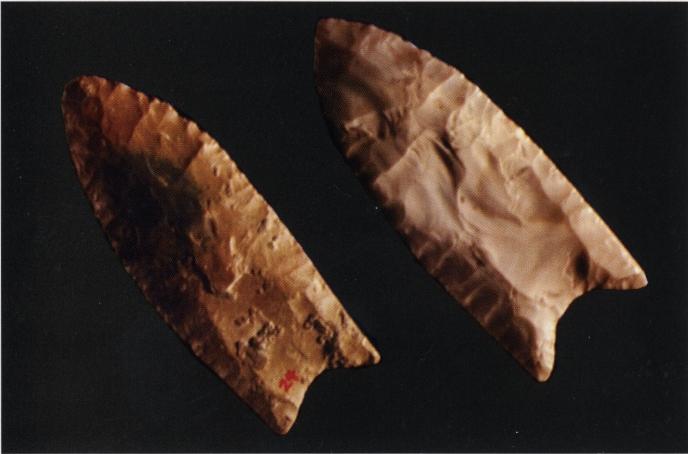by Col.John F Berner
Originally Published in the Central States Archaeological Journal, Vol. 57, No.1, pg.18

Lithic reproductionists, commonly referred to as flintknappers have nearly perfected the replication of Clovis paleo forms. Since the 1980’s, ascending prices for ancient authentic specimens has driven a new market for authentic appearing replicas. The privileged few whose financial availability is not limited, willingly invest large sums to secure genuine, authentic artifacts. I have always sought items of authenticity. Undaunted by limits of income I sought refuge by enjoying the collections of friends and acquaintances. Thirty years ago, I began to experiment with flint knapping. I learned hard hammers and soft hammers for percussion flaking. I used an antler tine to pressure flake. I learned how to set up a platform by dulling the edge in order to remove the next flake. I always finished each exercise by destroying my work and depositing it in a landfill.
In Warren County, Ohio 1968, I discovered an Adena flint knapper’s tool kit containing stub antler flakers, bone awl flakers and several small sandstone abraders. I tried a small sandstone abrader to polish the bases of my modern projectiles and remove unwanted loose flakes. Comparing my meager attempts to those more proficient than myself (under microscopic examination) I quickly recognized that my work did not compare favorably with that of the ancient knappers.
About 12 years ago at the annual Owensboro show in Kentucky, a proficient knapper from the North East filled an eight foot table with hundreds of impressive fluted Clovis reproductions. Each measured from 2 3/4″ up to 4 1/2″ in length and priced his work at $10 per inch. I inquired how he removed loose hinge flakes and he stated that he used a quartz ball. When asked how he polished the stem and bases, he again said the quartz ball. What he was talking about was applying a small hammerstone of quartzite to reduce the sharpness of the edges and faces of his points.
At top, a real Clovis Point is on the left. It is 3 inches in length. It is made from Bailey Chert and was found by Dan Figgins on the Malden Plain, Dunklin County, Missouri. The point on the right, was made by a knapper in 1999 who lives in Connecticut. It has been artificially aged in an attempt to deceive. This particular knapper has claimed he can fool every living authenticator. Don’t let his work or that of other modern knappers fool you.
Selecting a small quartzite hammerstone, I experimented and again compared the results under a microscope; but my disappointment was the same. My efforts compared favorably to that of the modern knappers, but it did not match ancient artifact work.
Over the next several years, I tried a number of techniques. I had noticed at knap-ins, most knappers used segments of modern grinding wheels to dull projectile bases and stems. I didn’t try that method as I knew that such tools were simply not available in ancient prehistoric times.
Undaunted by my failure to duplicate that of the ancients, I tried a variety of other abrading materials without success.
After reading a professional report mentioning the finding of strange wear patterns on flint debitage flakes found at a Paleo site, I became curious. Flint is a much harder substance than was used on other experiments. So I removed several lamellar flakes from a flint core and used them to abrade the stem and basal areas of an experimental projectile. The feel was similar to that of an ancient Clovis point, but how would it compare under microscopic examination?
I used a trinocular 45x scope with a video camera assigned to the third port , connected to a color CRT which increases the image to about 150x. Comparing the recently abraded flint experiment to ancient Paleo projectiles provided an answer I had sought for more than thirty years. Why not?
Ancient man need not have carried an extensive tool kit, as material needed to polish the base and stem of projectiles was there, available in his debitage pile!
The story does not end here. Not only must you select the right substance, you must use that material in a way so the finished base and stem won’t cut the hafting that secures a projectile to the shaft.
A friend who specializes in Paleo noticed that the polish on the projectile stems of ancient Paleo points was always perpendicular to the base.
He had noted that both the grinding and polish was “up, over and down”. This would indeed prevent cutting the hafting. Several years ago, a respected authenticator argued with me that the direction of the polish should be parallel to the stem. So much for that! A knapper/collector who does not sell his experiments, advised me that all authentic Clovis projectiles will also feature a small pressure removed flake from the base of the fluted area, and this reduction is polished. Its purpose is to assist guiding the fluted projectile onto the mounting shaft. Every genuine authentic Clovis point should have this feature, and if it doesn’t, it probably is not real!
Some may fault that sharing these secrets could aid dishonest knappers. However, with this newly acquired knowledge, some serious collectors might recognize the differences between the good, bad and the ugly. And it also may make it more difficult for the dishonest to sell previously knapped Clovis reproductions that were incorrectly manufactured.
I am proud to state that I was the first person in modern history to expose frauds through my 304 page book entitled “American Indian artifacts, genuine or reproduction” published in 2001.
This experimentation that led to discovery has been enlightening to say the least, and certainly worthwhile to me as now I might recognize the difference between real and fraudulent. Thanks for listening.
“Used by Permission of the Author”
To learn more about or to join the Central States Archaeological Society, click here: http://www.csasi.org/ .
